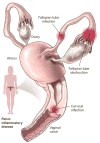Subunit vaccines for the prevention of mucosal infection with Chlamydia trachomatis
- PMID: 26938202
- PMCID: PMC4981183
- DOI: 10.1586/14760584.2016.1161510
Subunit vaccines for the prevention of mucosal infection with Chlamydia trachomatis
Abstract
Chlamydia trachomatis is the most common preventable cause of tubal infertility in women. In high-income countries, despite public health control efforts, C. trachomatis case rates continue to rise. Most medium and low-income countries lack any Chlamydia control program; therefore, a vaccine is essential for the control of Chlamydia infections. A rationally designed Chlamydia vaccine requires understanding of the immunological correlates of protective immunity, pathological responses to this mucosal pathogen, identification of optimal vaccine antigens and selection of suitable adjuvant delivery systems that engender protective immunity. Fortunately, Chlamydia vaccinology is facilitated by genomic knowledge and by murine models that reproduce many of the features of human C. trachomatis infection. This article reviews recent progress in these areas with a focus on subunit vaccine development.
Keywords: Chlamydia; adjuvant; antigen; immunoproteomics; tissue-resident memory T cells; vaccine.
Figures


References
-
- World Health Organization. 2015. Progress report of the implementation of the global strategy for prevention and control of sexually transmitted infections: 2006–2015.
-
- US Center for disease control, Division of STD prevention. 2014. Sexually transmitted disease surveillance 2013.
-
- Owusu-Edusei K, Jr, Chesson HW, Gift TL, et al. The estimated direct medical cost of selected sexually transmitted infections in the United States, 2008. Sexually transmitted diseases. 2013;40(3):197–201. - PubMed
-
- Brunham RC, Gottlieb SL, Paavonen J. Pelvic inflammatory disease. The New England journal of medicine. 2015;372(21):2039–2048. - PubMed
-
- Brunham RC, Pourbohloul B, Mak S, White R, Rekart ML. The unexpected impact of a Chlamydia trachomatis infection control program on susceptibility to reinfection. The Journal of infectious diseases. 2005;192(10):1836–1844. - PubMed
Publication types
MeSH terms
Substances
Grants and funding
LinkOut - more resources
Full Text Sources
Other Literature Sources
Medical
